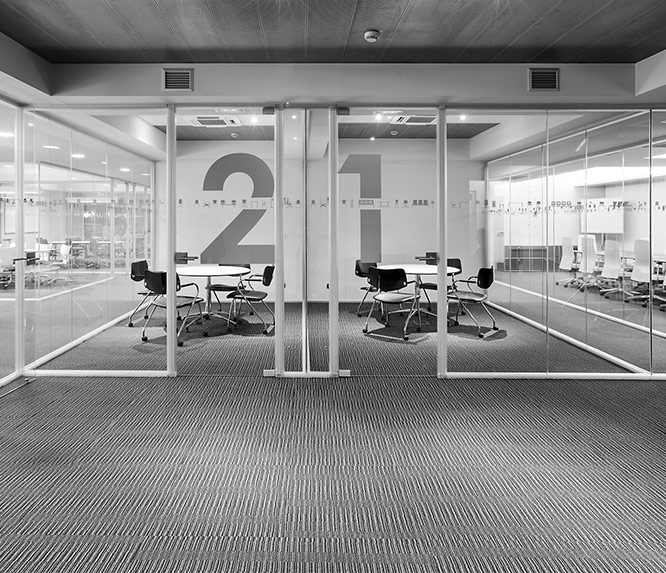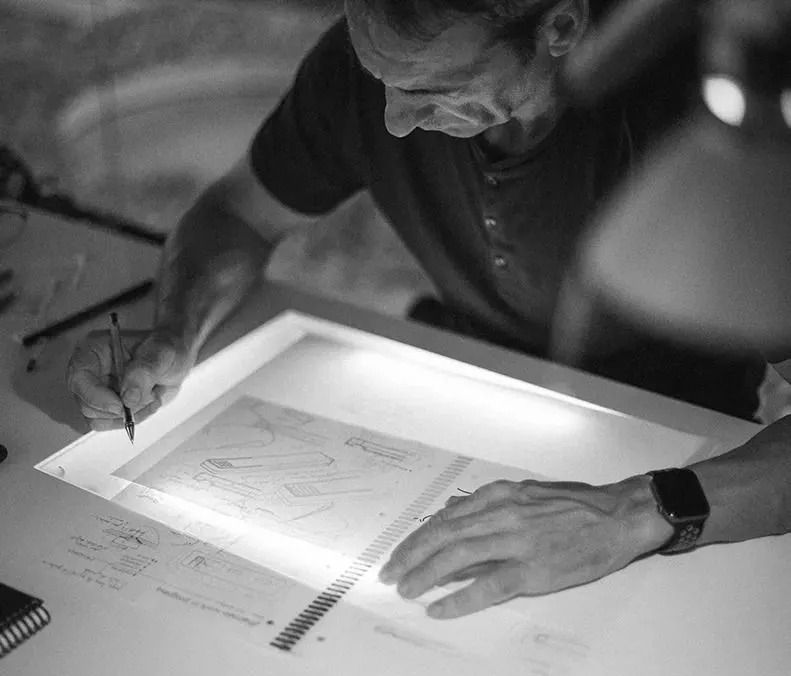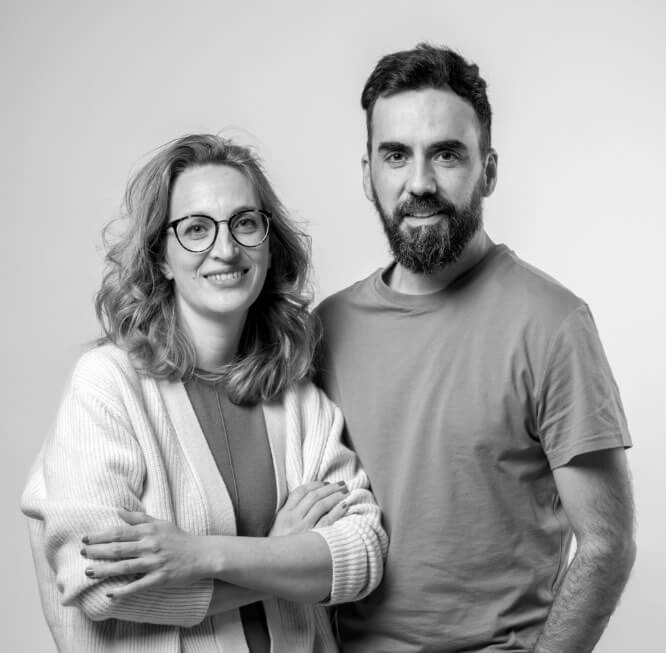
ABOUT
COMPANY
Many things can happen, many stories take place around chairs. Many more around a company.
Akaba was born as a deeply social and inclusive company, and those values endure and lead the way.
They guide our management model, and also our way of understanding creation. We manufacture furniture for communities, which seeks social encounter starting with the individual. We create furniture for spaces with a human dimension that invite people to talk, relate and create collectively.
HISTORY
BORN IN '86, THE HEIRS OF '68
Akaba has been a free-thinking project from the outset. We were born into a situation of cultural unrest that had its roots buried deep in a period of profound change. We saw the light with a perfectly defined profile combining the love for design and transgression; but also marked by our environment's industrial DNA. Design and manufacturing represented the two sides of a same process, of a same entrepreneurial identity.
1986 - FROM DESIGN TO ART
We establish the company and set about combining design and art in avant-garde pieces, a model that would shape the future. But always with our sights on the functional and practical aspects. Designers like Mariscal and Calatrava participate in the creative process. Our attendance of international fairs (Paris, Cologne, Milan, etc.) earns us outstanding presence in all specialized magazines. And international recognition arrives.
1989 - FROM HOME TO BUSINESS INTERIORS
The decade of the '80s ended with a process of change in the company: with no loss of quality and without abandoning design, we focus on a more functional type of product. A change of direction occurs: from household furniture to contract or installation furniture. We start to produce furniture with a greater sales projection.
1994 - GORKA, THE TAKE-OFF
A crucial year for Akaba. Gorka represented not only the birth of a new product, but of a true icon. The company grows to the rhythm of the fame and prestige enjoyed by this product, the result of careful investment. All without forgetting the enormously important human factor during that period of growth.

1995 - BILBAO METRO WITH FOSTER + PARTNERS
Working hand in hand with Norman Foster and his team, we design and manufacture the seating for the Bilbao metro. Taking a design by Norman Foster, we joined hands on moulding it with the goal of improved ergonomics.

2000 - LOIU AIRPORT WITH CALATRAVA
Bespoke manufacturing for a singular project. Designed by the architect Santiago Calatrava, the benches in Loiu airport perfectly match the terminal design. Respecting the original design and the aesthetic value they bring to the space, we manufacture the benches in special hardwearing timber: Canadian cedar wood.
2000 - RECOGNITIONS AND AWARDS
In the 2000s, Akaba receives institutional recognition in the shape of the highest national accolades: the National Design Award and the Prince Felipe Award for Business Excellence. The second of the two acknowledges our management model, with its collective and social approach to the focus on people.
2008 - NEW FACILITIES IN USURBIL
The decade ended with a company made up of 70 people in three different locations. This prompted Akaba to take the jump and build new centralized facilities. Our new centre has state-of-the-art services: a smart warehouse, a hugely efficient production model, an impressive showroom occupying 800 square metres, a gastronomic club inviting workers to meet… are the facilities subsequently introduced by Akaba.
2009 - STRENGTH TO WEATHER THE STORM
That change coincides with a complicated time for the sector, in the midst of an economic crisis that shook it to the core. Innovation and our values help us to weather the turbulent times, also enabling us to improve: we were able to broaden our skills and felt better prepared.
2016 - RETURN TO OUR ROOTS
If Gorka was the take-off, Kabi represented confirmation of Akaba's ability to create yet another extensive range of contract chairs. Once again we collaborated with Jorge Pensi, the same designer we worked with to create the Gorka chair. The single-piece polypropylene seat and steel tubes mark the character of this new collection.
2018 - GENERATIONAL CHANGEOVER
The generational changeover arrives. A new generation of women, taking up our full business DNA and injecting it with new sensitivity. Akaba incorporates new designers to its team of collaborators, opening the way for the launch of new products incorporating the brand trademarks of design, creativity and reliability.
WORKING SOCIETY
Our products are the result and also the tool of a working society. Akaba's goal is to enable the strength of shared creation, just as our environment and its qualities enabled our birth and development.
We saw the light in a land that transmitted the value of effort, the love of materials and the passion for innovation. A land where we have been accompanied since prehistoric times by iron, a material we have modelled to become the present and the future.
That DNA of our land is also the DNA of Akaba. The DNA of a working society.
WORKERS
Workers change the way they go about their jobs; the office is revamped as a forum of knowledge, of task-oriented design, of people-oriented design. Work and pleasure join hands in reinvented spaces, construed for brainstorming and worker interaction.
Today space and furniture design is approached holistically, to accommodate movement. Nowadays we only sit at a desk for 45% of our time, spending the remainder at meetings in different spaces.
ORGANIZATIONAL CULTURE
Organizations continually reinvent themselves: How can we improve next time round? What values do we want to transmit? What attitudes and behaviours will make our customers understand who we are? Other forms of management are being embraced, abandoning vertical hierarchy and seeking more collaborative methods. Organizations therefore directly draw on their employees' creativity, energy and power. They are the ones who promote innovation and ideas.
REDESIGN
Today redesigning the space of these new organizations favours an approach to work as a meeting space, as a medium for human relations. A productive relationship from which more advanced projects are born. Architecture studios, all kinds of offices, creative environments… focus their renovation studies on creating communities, on fostering meeting and collaboration. Redesigning spaces and furniture also means redesigning the selfsame company concept.
KNOWLEDGE
Knowledge becomes the mainstay of organizations. Shared knowledge requiring its own space for plural and dynamic, interactive and cooperative participation. And that new knowledge culture implies a new entrepreneurial culture, where fostering flexibility and personalization is key. The worker must be equipped with as many measures as possible if they are to align upgrades in their mindset with innovations in their sector, with learning from success stories and with the difficulties overcome by means of collective intelligence.
IN PROGRESS
A working society is a society desirous of continuous progress. Self-discipline encourages efforts to achieve excellence, always looking ahead, always innovating.
Ours is an increasingly more international society, where innovation is an intrinsic part of company identity. The spaces for that innovation have changed the scenario of businesses and of work stations
NEW
Today everything is permanently new. And that permanent newness keeps us constantly in the loop… enabling us to build a better future. Those new redesigned work spaces represent benefits for companies capable of reorganizing themselves around the new space, rather than simply having it installed and continuing to do things as they always have.
GLOBAL
The future, like the present, will develop in a globalized world. Global markets for products, global markets for workers who are free to move around without borders to hinder exchange.
A future for those with no fear of growth, for those who generously give the best of themselves to those they work with.
That's how the corporative enterprises of our land took shape, with employees who would in time become owners and who fought tooth and nail for their commitment to a project. Today many of those companies live their own future as world leaders in their respective sectors.
SPACE
Space matters. The design of the physical space, always people-oriented, must foster knowledge, collaboration, consultation and experimentation. It must achieve balance between the needs of the individual and those required by collaborative work, constituting a virtual learning space where users can interact with one another and with the source of knowledge while generating networks of reflection and social exchange.
Space shapes behaviour. A singular space is a success in so far as it gives the workers what they need, whether as teams or as individuals. Similarly, round tables may create a social culture with no corners, open, collaborative and sustainable.
OBSERVE
Observing everyday work in the office facilitates evolution towards operational excellence. A company in permanent movement, which analyses and observes itself, continuously introducing improvements to its processes, will eventually conceive more original solutions enabling it to offer its customers the best possible responses.
CONNECTIONS
High quality design in work spaces is a way to attract and retain talent. The comfort of these spaces, the ergonomics of the furniture and its environmental sustainability become essential. When we transform work into a place to meet and interrelate, when we achieve collaborative experience and coordination, the worker becomes part of a team connected to one another and to the company.
People, work and culture interconnected with the work space create a lever for organizational change and development.
ENVIRONMENT
How can we combine constant progress with environmental sustainability? By seeking the highest possible efficiency: of the materials used, of travel by workers, of their productivity. The workplace must be a model of sustainability and efficiency.
Efficiency in processes (adapting to needs), efficiency with respect to posture (ergonomics), efficiency in economic sustainability (appropriate investments), sustained over time (durability).
INVESTMENT
The continuous need for innovation and search for effectiveness means that the working society requires constant investment in products, services and spaces. Industry progresses thanks to interactions with its customers; ideas flow constantly… and advances are achieved which require a permanent process of improvement.
Investment in work spaces is also a must. The improved concept of chairs, desks and other office furniture will boost collaboration and improve wellbeing among company members.
TIMELESS
Timeless design, using resistant materials, is the guarantee of durability. It is the guarantee that the spaces created today will remain functional and practical with time, despite the transformative power of a society forever on the move. Time may bring us new technologies, new mechanisms of knowledge transfer, transformations that we can't even imagine today.
But quality work spaces will always be a must. Timeless design and attractive, lasting materials will accompany us on that time travel into the future.
YESTERDAY
That better and more sustainable future takes its inspiration from yesterday, from our past, from what we once were. We must remember the past if we are to better understand the legacy of the working society, to know which direction to take, how to improve and evolve. Because the working society, our society, gave us the value of effort, the love of materials and the passion for innovating.
These values are ours, they are part of our fibre. Bearing our origins in mind keeps us forever young as we progress towards the future, year after year.
DESIGNERS
Our designers apply their experience and talent to making each piece unique. At Akaba we also enjoy a shared vision with each of our collaborating designers. All of our collections therefore share a common design DNA providing unity throughout while conveying the brand values.

































